Why embracing green technologies can save you money
24 September 2024
The crane and specialized transport industry is embracing new eco-technologies and adopting sustainable practices. While contributing to environmental sustainability, it’s also proving to be cost-effective for companies. Niamh Marriott reports.
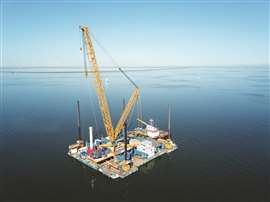 Heavy lift giant Sarens is focusing on its ESG initiatives and work in various renewable energy sectors. (Photo: Sarens)
Heavy lift giant Sarens is focusing on its ESG initiatives and work in various renewable energy sectors. (Photo: Sarens)
Whether it’s the use of HVO fuel or fully electric cranes, smart battery solutions and greener transport options, investing in repairing new cranes, setting new ESG goals or imposing environmental standards for sites, the industry is leading the way, reducing its carbon footprint and its impact on the planet.
Though the crane rental market worldwide remains significantly influenced by the oil and gas sector, there is a lot of work available in the different renewable sectors. These offer projects, particularly in wind energy, with new projects offshore gaining traction. There is demand for green solutions, and work available in green sectors, and the industry is taking note.
Repair and reuse
Crane manufacturers worldwide are continuing to look for ways to meet customer sustainability requirements while continuing to offer competitive pricing. One of these solutions is the remanufacture of cranes already in use.
Many of the larger manufacturers already offer repair solutions for cranes, either as part of their after-care service or as a separate, dedicated division of their business.
Manufacturer Manitowoc has its EnCore programme. The company says that whether a crane requires repair due to damage caused by an accident, or needs an end of service life rebuild, EnCore gives a viable option over a new crane purchase.
It says the key advantages of remanufacturing include maximising your investment, reducing downtime and security in the knowledge that the crane has been restored to industry-standard and engineering specifications. Manitowoc also offers a component exchange programme.
Nearly new
German crane specialist BKL says it not only offers a range of new tower cranes but can also provide “nearly new” and used cranes too.
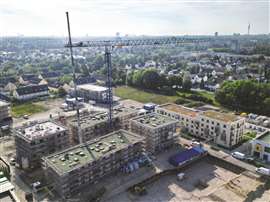 German crane specialist BKL now offers nearly new and used cranes. (Photo: BKL)
German crane specialist BKL now offers nearly new and used cranes. (Photo: BKL)
This also includes parts and accessories. Its cranes can be serviced and repaired by BKL’s technicians. New to BKL is its purchase of used cranes. The company says its crane team is looking to buy or trade used construction cranes.
Japanese manufacturer Tadano offers repair work as part of its after sales service at its factory in Lauf, Germany, where it has a specialist crane workshop. At the workshop, cranes for repair are examined and inspected so the team can prepare a cost estimate and time expectation for works. The work is then carried out with original spare parts and any new functions or features can be added to modernise the crane, Tadano says.
Partner up
Announced during the Bauma construction equipment exhibition in October 2022, Crowland Cranes and Avezaat Cranes formed a joint service partner agreement. The two companies have already worked closely together in recent years on crane repair projects.
Wind work
Many crane and specialized transport companies are finding a plethora of work in the wind energy sector. Luxembourg-based transport company Faymonville has created new products to help move large wind turbine components to their construction sites.
“Renewable energies have been an important topic for some time,” says a spokesperson for the family-run company. The Faymonville Group’s recent WindMover Days event highlighted the company’s dedication to the evolving wind power industry by showcasing specialized transport solutions for increasingly larger wind tower elements and rotor blades.
“The wind power industry in particular is subject to continuous development. Offshore systems and wind farms are growing continuously, as are the dimensions of the wind tower elements and rotor blades – and with them the transport challenges.”
Over four days, around 250 industry experts explored Faymonville’s high-tech offerings, including the WingMax flatbed trailer, Cometto BladeMax1000, and various self-steering and low loader trailers designed for efficient and safe wind turbine component transport.
These innovations not only enhance transport capabilities but also reduce costs and environmental impact.
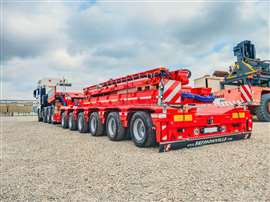 Italy-based wind turbine transport specialist Societa Autotrasporti Eccezionali (SAE) took delivery of two new 6-axle MegaMAX lowbeds from Faymonville last year. (Photo: Faymonville)
Italy-based wind turbine transport specialist Societa Autotrasporti Eccezionali (SAE) took delivery of two new 6-axle MegaMAX lowbeds from Faymonville last year. (Photo: Faymonville)
Collaborative efforts
Many new collaborations and joint ventures are being formed around the world, with a focus on the energy transition and creating a sustainable future.
Recently, Japanese crane manufacturer Tadano announced a new global collaboration with Danish wind turbine manufacturer Vestas to develop wind turbine nacelle cranes. The nacelle cranes are designed for Vestas’ V236 offshore wind turbines.
Tadano says, “We aim to contribute to the offshore wind power generation sector, which is also being promoted by the Japanese government, through our product lineup, and we strive to achieve carbon net zero by 2050.”
Tadano says, “We believe that by leveraging our strengths and long history as a crane manufacturer, we can contribute to the spread of offshore wind power generation, which is one of the important energy policies of the Japanese government.”
In its mid-term management plan for 2024-2026, Tadano stated that advancing decarbonisation is a key driver for the company’s growth strategy and it committed to developing environmentally sound products.
ESG
Belgian-headquartered lifting giant Sarens has been implementing its ESG initiatives for several years and continues to focus heavily on sustainable practices throughout its global work.
The company has launched the Sarens Sustainability Accelerator to drive smarter engineering solutions and cleaner energy opportunities, particularly in the wind and clean energy sectors. Sarens developed a giant electric crane, the SGC-90, which can connect to the electricity grid and also produce its own energy regeneratively, with zero emissions.
Sarens received the EcoVadis Bronze Medal for commitment to environmental, social, and corporate responsibility.
Sarens is also investing in hybrid cranes and low-emissions technology, ensuring new fleet additions meet stringent emissions standards. In addition, it is researching electric SPMT power packs, promoting recycling, and reducing energy consumption across its offices.
Sarens has established partnerships for sustainable wind energy projects and zero-emissions initiatives in nuclear energy. It is also prioritising protection of marine life by switching to biodegradable oils and powering its offices using solar energy.
Through these efforts, Sarens is significantly contributing to the global energy transition and fostering a culture of sustainability in the company.
We spoke exclusively to Sarens’ commercial director of project solutions, Yannick Sel, to learn how the heavy lift giant is leading the lifting and transport work in the energy sector. The full interview is available here.
“I think we all have to work together as an entire supply chain and really make these projects happen with the bigger goal in mind, a more sustainable future,” he says.
He agrees the industry needs to work together to meet future demand. “It’s really about getting the right outlook. Everyone looks only at their own projects but I think sometimes we need to have thinking on a higher level, to also save costs.”
Zero emission lifting
International heavy lift and transport specialist Mammoet is innovating with zero-emission lifting and transport on site to help its customers reduce the carbon footprint of their projects.
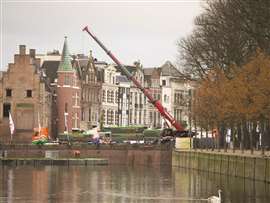 Innovation in electrification and alternative fuels are key in Mammoet’s drive towards net zero emissions. (Photo: Mammoet)
Innovation in electrification and alternative fuels are key in Mammoet’s drive towards net zero emissions. (Photo: Mammoet)
Mammoet’s head of sustainability Mathias Hoogstra, says, “If you ask me what my main vision is, I want us to redefine the construction site – at least at small scale initially – where we have electric or hydrogen cars, electric cranes, electric trucks, and have all this equipment cross-link and charge each other.”
Mammoet sees sustainability as an important factor in the future of the heavy lifting and transport industry, and is working on electrifying its crane fleet. A major challenge is the sheer scale of the huge and heavy loads involved.
Recent developments, however, mean an entire project can now be done without engine exhaust emissions. This is achieved using equipment already introduced to the market. Sustainability in heavy industry offers big rewards for sufficiently adaptable companies.
Hoogstra explains, “You see now, in government legislation but also in the tendering process, solutions that are adhering to zero emissions score more points.
“I wouldn’t say the whole flood wave is already there, but the first change is starting. If you want to be a leader in the market, in my opinion, you must ensure that you are leading this whole transition and are at the forefront for your customers.”
Electric SPMT
Self propelled modular transporter (SPMT) is used on many projects so it makes sense to electrify it for net zero heavy transport. Mammoet used an outside supplier and the first electric Power Pack Unit (ePPU) prototype was tested at Mammoet in Schiedam, Netherlands.
In terms of capability there is no significant difference between electric and diesel-powered SPMT and both offer a capacity of 40 tonnes per axle line, Mammoet says. Dimensions and mounting position of the ePPU are the same as the diesel one.
Battery charging from 0 to 100 per cent takes around five and a half hours, meaning it can be done overnight ready for the next day.
Swapping out the PPU diesel engine and fuel tanks for an electric motor and battery helps sustainability by future-proofing existing equipment and it extends its service life. More information about Mammoet’s efforts can be found here.
More electric cranes
Other manufacturers and companies are taking note of the rising popularity of electric cranes.
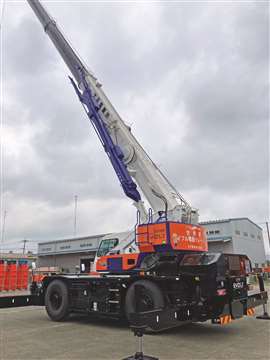 Tadano’s EVolt eGR-250N is the world’s first fully electric rough terrain crane. (Photo: Tadano)
Tadano’s EVolt eGR-250N is the world’s first fully electric rough terrain crane. (Photo: Tadano)
In April 2022 Tadano announced it was working on a fully battery-electric rough terrain crane and that development has now reached fruition.
It says its EVolt eGR-250N is the world’s first fully electric rough terrain crane put into practical use, further describing it as “a pivotal addition to Tadano’s commitment to reducing carbon emissions and embracing sustainable practices.”
EVolt is designed to offer the same performance as its diesel equivalent. Working radius is 34 metres, its maximum lifting height from the ground is 44.2 metres, and it can travel at up to 49 km/h.
Italy-based Marchetti launched its CW 25. 35 HY fully electric telescopic crawler crane at the Intermat 2024 trade show in Paris, France, late April 2024.
The new crane has a 17 tonne pick and carry lifting capacity and boasts a compact size, with a total weight of 25.5 tonnes. Power comes from an electric motor and lithium batteries and the crane carries 3.3 tonnes of counterweight.
As previously reported, a battery power option is now available on three more hydraulic articulating loader or knuckle boom cranes in the HiPro series from Hiab.
In addition to having a battery-powered electric power take off (ePTO) the crane hydraulics can still be powered via a conventional power take off from the truck’s diesel engine.
Called Hiab wspr, it is an option on mid-range Hiab loader cranes in the HiPro range.
“A Hiab wspr solution, operated by electric power, is better for people and the planet as it is emission-free and future proofs businesses for stricter regulations,” says Mattias Berglund, Hiab director, global product management, special applications and digital products, loader cranes light and medium.
“By being emission-free and near silent it also provides the flexibility to operate in low- or no-emission zones, or late at night, thereby increasing business opportunities.”
Financial incentive
The TII Group is promoting sustainability in the transport and logistics industry in a novel way - by offering a €70,000 TII environmental bonus on the purchase of the fully electric Kamag ePrecisionMover (ePM) swap body transporter.
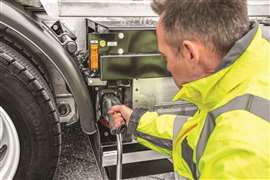 TII Group is offering a financial incentive to promote sustainability. (Photo: TII)
TII Group is offering a financial incentive to promote sustainability. (Photo: TII)
This incentive is available for the remainder of 2024 and comes as a response what the company says is the cessation of major government funding for climate-friendly commercial vehicles.
The third generation of the Kamag ePM boasts several technological advancements, including increased vehicle voltage for faster charging and greater energy efficiency. It has a 140 kWh battery pack, allowing up to 10 hours of operation with a full recharge possible in 90 minutes.
The industry is making significant strides in embracing eco-technologies and sustainable practices. As the work available shifts towards greener operations, it not only benefits the environment but also proves to be cost-effective.





